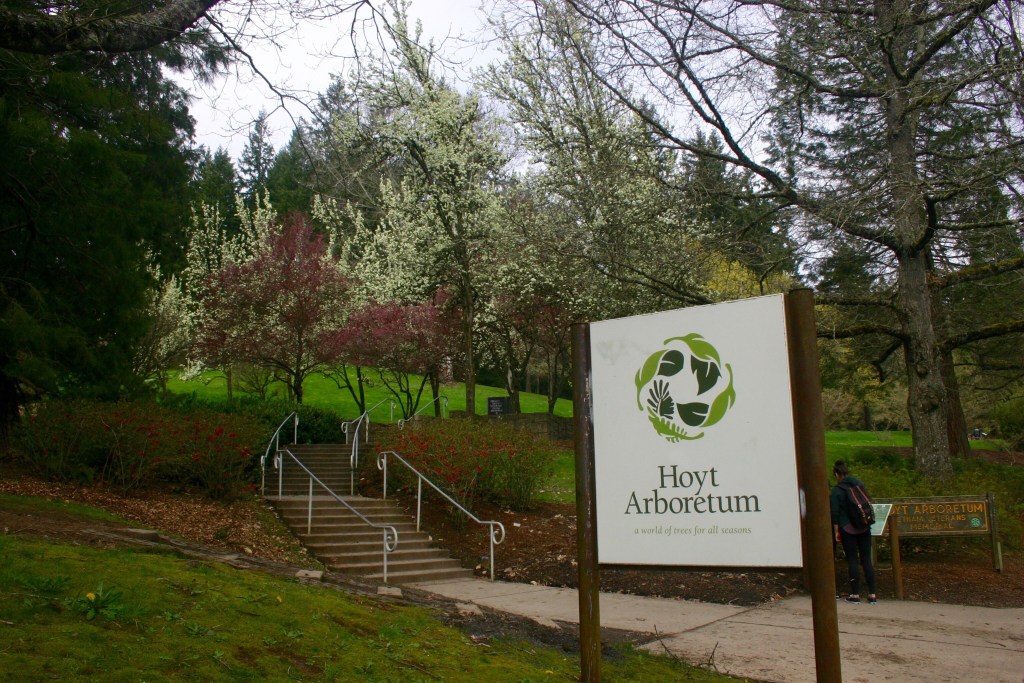Orange, yellow, brown and red! From the tops of the trees to the ground beneath our feet, autumn in the Pacific Northwest is a kaleidoscope of color, and one of the best places to experience it is at Portland’s Hoyt Arboretum.

What You’ll Find
Located within Northwest Portland’s Washington Park, the Hoyt Arboretumis home to approximately 6000 individual trees and shrubs of more than 2000 species from all over the world, including 63 vulnerable or endangered varieties. (Visitors will find labels identifying common and scientific names and the region of origin throughout the park.)
The arboretum is home to a nationally recognized collection of magnolia trees and one of the most extensive conifer collections in the country. Look for the dawn redwood, a needle and cone bearing deciduous conifer that loses its “leaves” in the winter. It was once thought extinct and known only in fossils, but was rediscovered in China in 1944 and reintroduced to the western hemisphere in 1948, with the Hoyt Arboretum as one of the first recipients. In the fall of 1952, the Hoyt Arboretum’s dawn redwoods claimed the first in the Western hemisphere to produce cones in about 6 million years.
Take a walk through the ornamental Winter Garden to find colorful cold weather flora and the bamboo garden where you’ll find over thirty different species of bamboo in over 100 plants. It’s thought to be the largest bamboo collection in the Pacific Northwest.
Originally, the arboretum included locations for nearly forty families of trees. Crews from the Works Progress Administrationcleared the forest and built roads and paths winding through the arboretum in 1930 and 1931. Since then, the arboretum’s boundaries have increased in size to its current 189-acres through additional donations and acquisitions and currently welcomes about 350,000 visitors each year.
The History of Hoyt Arboretum
The land that Hoyt Arboretum sits upon was granted to Oregon’s earliest pioneers in 1850 as part of the Donation Land Claim Act for farming and logging. The project failed and the land was then in the control of Multnomah County. After fire overtook a part of the area in 1889, 160-acres were turned into the Multnomah County Poor Farm Hillside Farm. In 1922, the Poor Farm closed and the City of Portland took control, turning it into park that later became Hoyt Arboretum.
Originally, the arboretum included locations for nearly forty families of trees. Crews from the Works Progress Administrationcleared the forest and built roads and paths winding through the arboretum in 1930 and 1931. Since then, the arboretum’s boundaries have increased in size to its current 189-acre through additional donations and acquisitions and each year welcomes about 350,000 visitors.

Hiking Trails, the Visitor Center and Guided Tours
Hoyt Arboretum has 12-miles of trails, marked with over 250 trail signs and interpretive panels (two miles are wheelchair accessible). The Wildwood Trailbegins at the arboretum and Forest Park, where the arboretum is located, is home to the Oregon Zoo, the World Forestry Center, the International Test Rose Garden, and many other attractions.

The arboretum’s visitor center, a small nature center and research library are open to the public and offer periodic volunteer-guided tours. Events and nature classes are planned throughout the year and the A-frame Steven’s Pavilion is the perfect place to stop for a picnic or reserve for a special occasion.

Getting to Hoyt Arboretum
Hoyt Arboretum’s grounds are free to the public and open from 5am-10pm. The visitor center is located at 4000 SW Fairview Blvd. and is open Monday-Friday 9am-4pm and Saturday & Sunday 10am-4pm depending on volunteer availability. On-site paid parking is available and the Washington Park Shuttle, which connects the arboretum to the MAX light railand the Tri-Met bus stop at the Washington Park station, is available for rides to Hoyt Arboretum’s visitor center.

Leave a Reply